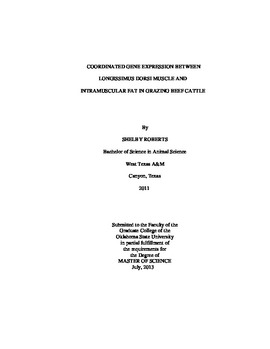| dc.contributor.advisor | Krehbiel, Clinton R. | |
| dc.contributor.author | Roberts, Shelby Leann | |
| dc.date.accessioned | 2014-09-24T14:18:38Z | |
| dc.date.available | 2014-09-24T14:18:38Z | |
| dc.date.issued | 2013-07-01 | |
| dc.identifier.uri | https://hdl.handle.net/11244/11184 | |
| dc.description.abstract | Previous research indicates that metabolism and fiber type of skeletal muscle is related to intramuscular lipid content. The objective of this study was to determine differences in the metabolism and intercellular signaling of skeletal muscle fibers within the same muscle group that could be responsible for the initiation of intramuscular adipose tissue development and differentiation. Longissimus dorsi muscle (LM) samples were collected from steers (n = 12; 385 days of age; 378 kg) grazing wheat pasture. LD samples were dissected under magnification and sorted into 3 categories based on visual stage of development: immature (MM), intermediate (ME) and mature (MA) intramuscular fat (IM). In addition, muscle fibers lying adjacent to each IM category and those not associated with IM tissue were collected and stored separately. Quantitative RT-PCR was used to determine relative fold change in genes involved in metabolism, angiogenesis, formation of extracellular matrix, and intercellular signaling pathways in both LD and IM samples. Gene expression data were analyzed using a general linear model that included the fixed effect of tissue. Pearson correlation coefficients were also computed between gene expression in LD and IM tissue samples that were at the same stage of development. Fatty acid binding protein 4 and PPAR? expression were greater (P<0.05) in more mature IM while PREF-1 expression was less (P<0.01) indicating successful separation into different maturity categories. Genes associated with metabolism and angiogenesis in LD tissue showed no differences among stages of development. Myostatin expression did not change in LD tissue; however, myostatin receptor and follistatin expression decreased (P<0.01) as IM matured. Collagen type I and VI had evaluated mRNA expression in the skeletal muscle associated with immature IM development. Angiogenic growth factors in MM IM tissue had a strong positive correlation (r>0.88) with angiogenic growth factors in LD associated with MM IM; however, no correlation was observed in ME or MA IM. These data indicate a coordinated effort between LD and IM in early stages of IM development. | |
| dc.format | application/pdf | |
| dc.language | en_US | |
| dc.publisher | Oklahoma State University | |
| dc.rights | Copyright is held by the author who has granted the Oklahoma State University Library the non-exclusive right to share this material in its institutional repository. Contact Digital Library Services at lib-dls@okstate.edu or 405-744-9161 for the permission policy on the use, reproduction or distribution of this material. | |
| dc.title | Coordinated Gene Expression Between Longissimus Dorsi Muscle and Intramuscular Fat in Grazing Beef Cattle | |
| dc.type | text | |
| dc.contributor.committeeMember | Horn, Gerald W. | |
| dc.contributor.committeeMember | DeSilva, Udaya | |
| osu.filename | Roberts_okstate_0664M_12908.pdf | |
| osu.accesstype | Open Access | |
| dc.description.department | Animal Science | |
| dc.type.genre | Thesis | |
